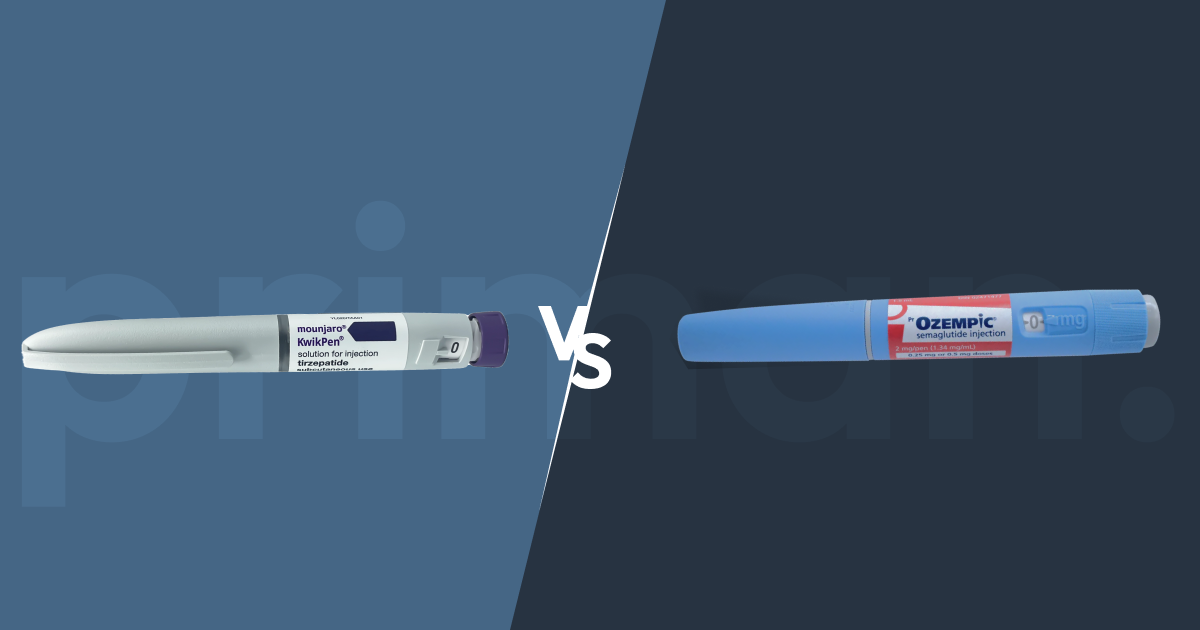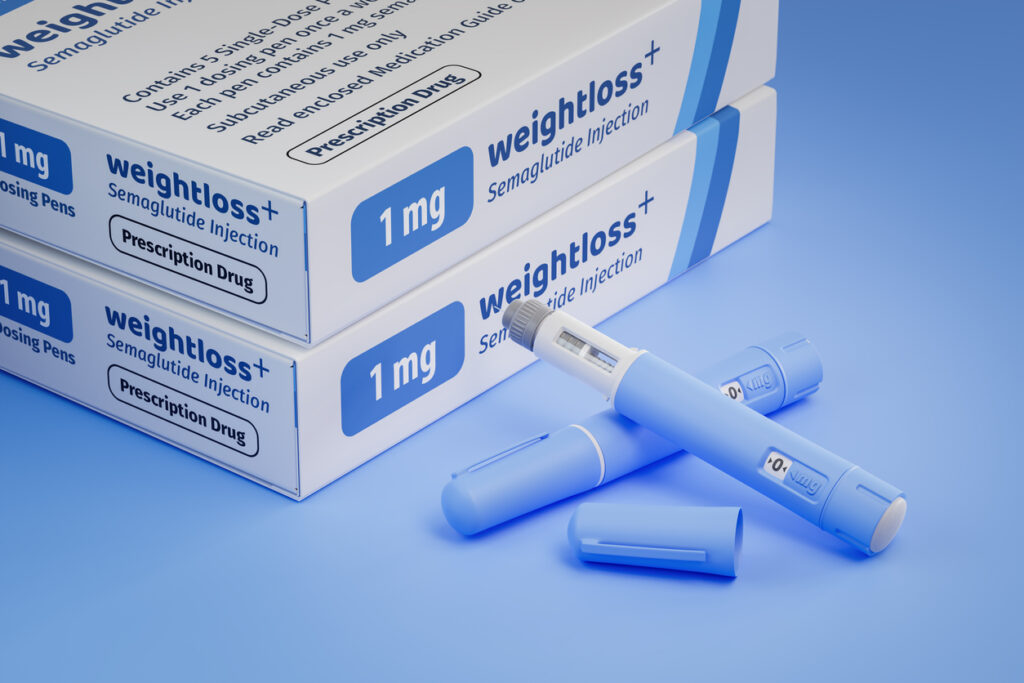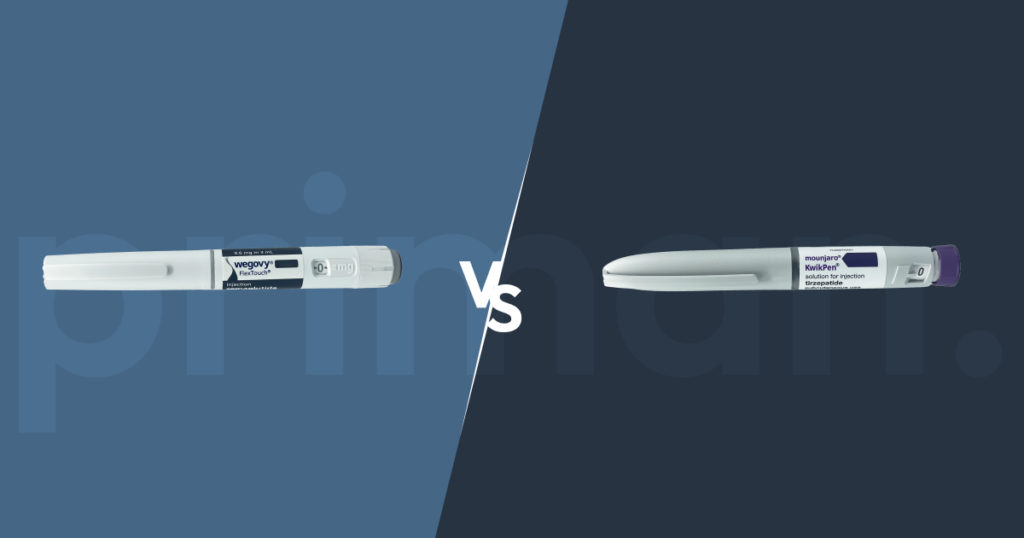Are you looking for ways to manage your weight? If so, you might have come across Mounjaro and Ozempic, two injectable medications that have shown promise in aiding weight loss. Studies suggest Mounjaro might lead to slightly greater weight loss. Additionally, Mounjaro is newly approved in the UK for weight management since November 2023, whereas Ozempic remains focused on blood sugar control. However, Ozempic has been available for several years. But with so much information available, it can be confusing to understand which one might be right for you. This blog dives into the key differences and similarities between Mounjaro and Ozempic to help you make an informed decision on weight loss medication injections.
| Mounjaro | Ozempic | |
| Active Ingredient | Tirzepatide | Semaglutide |
| Drug Class | GLP-1 and GIP receptor agonist | GLP-1 receptor agonist |
| Weight Loss Up to | 20% | 15% |
| Maintenance Dose | 15mg | 2.4mg |
| Dose | Once weekly dose | Once weekly dose |
Head-to-Head: Mounjaro and Ozempic
Mounjaro and Ozempic are MHRA approved prescription medications delivered by weekly injections. They target both blood sugar control and weight management in qualified adults. Both belong to a drug class called GLP-1 receptor agonists, which influence specific hormonal functions in the body.
Mounjaro was initially approved for type 2 diabetes injection to improve blood sugar control. Recent studies, however, show its effectiveness in promoting weight loss for obese patients when combined with healthy eating and exercise habits. The key ingredient in Mounjaro, tirzepatide, curbs appetite by impacting areas of the body responsible for hunger signals. It also assists the body in managing blood sugar spikes after consuming carbohydrates.
Ozempic (semaglutide) is an injectable medication designed for type 2 diabetes, but it may also offer weight-loss benefits. While initially prescribed off-label for weight management, Wegovy, another brand-name semaglutide injection, was later introduced specifically for weight loss.
Ozempic helps regulate blood sugar by reducing cravings and boosting insulin production. Studies show that obese patients incorporating weekly Ozempic injections with a healthy diet and exercise saw significant weight loss within a year.
Healthcare professionals may prescribe Ozempic off-label for weight management, but Wegovy is the preferred option with its dedicated approval. Click here to learn more about Wegovy.

Effectiveness in Weight Loss
Both Mounjaro and Ozempic are medications that can help with weight loss, but studies suggest Mounjaro might be slightly more effective. However, it’s important to combine either medication with healthy lifestyle changes for the best results.
Mounjaro
Studies show that Mounjaro injections, when combined with diet and exercise advice, can lead to slightly greater weight loss compared to other injectable diabetes medications. For example, people who used Mounjaro for 72 weeks alongside lifestyle changes lost up to 20% of their initial body weight.
Ozempic
Research also supports Ozempic’s role in weight loss when used with healthy habits. Participants in studies who incorporated better eating and exercise routines while taking Ozempic once a week experienced a significant reduction in body weight up to 15% over 68 weeks.
Eligibility Criteria
Adults with obesity, a condition defined by a body mass index (BMI) of 30 or higher, might benefit from prescription weight loss medications like Mounjaro and Ozempic.
Your healthcare professional will determine your eligibility for these medications by calculating your BMI and reviewing your medical history. Your clinician may prescribe these medications along with diet, exercise, and lifestyle changes to help you lose weight and improve your overall health.
It’s important to note that these injectable medications aren’t suitable for everyone.
Complete a quick Priman online assessment to see if it is a safe and suitable choice for your weight loss journey.
Here’s a breakdown of eligibility for using Mounjaro and Ozempic:
Mounjaro is a medication recently approved to help people with long-term weight management. It may be suitable for you if you have:
A body mass index (BMI) over 30, along with a weight-related health condition, such as high blood pressure, high cholesterol, sleep apnea, or osteoarthritis.
It’s important to note that Mounjaro may not be right for everyone, especially those with a history of certain health problems like thyroid, pancreatic, or gallbladder disorders.
Ozempic is a medication designed to help manage blood sugar in type 2 diabetes, not weight loss. Therefore, it shouldn’t be used solely for weight management.
While studies suggest Ozempic may lead to weight loss as a side effect, it’s important to consult your healthcare professional. They can assess your health and medical history to determine if Ozempic is right for you.
How to Use?
Both Mounjaro and Ozempic are self-administered medications delivered through pre-filled injection pens. Here’s a breakdown of how to use:
Mounjaro:
- Dosage: Starts at 2.5mg weekly, increasing to a maximum of 15mg over time.
- Injection: Weekly, under the skin (stomach, thigh, or arm) using a prefilled pen with a thin needle.
- Preparation: Refrigerate the pen until 30 minutes before injection.
- Disposal: Dispose of capped needles in a designated sharps container.
Ozempic:
- Dosage: Starts lower at 0.25mg or 0.5mg weekly, increasing to a maximum of 2mg.
- Injection: Similar to Mounjaro
- Preparation: Refrigerate the pen before use. Once in use, store at room temperature for up to 6 weeks below 30°C.
- Disposal: Similar to Mounjaro
Mounjaro vs Ozempic Side Effects and Safety
Mounjaro, like most medications, can cause side effects in some people. But good news – most are minor and temporary, especially as your body gets used to it in the first month.
The most common side effects are gastrointestinal effects like diarrhea, indigestion, vomiting, constipation, or abdominal pain. You might also feel nauseous or lose your appetite. These usually hit you early on and go away as you continue treatment.
Serious side effects are rare, but can include inflammation of the pancreas or gallbladder problems. Allergic reactions are also uncommon.
Overall, studies show Mounjaro to be safe in clinical trials, with no safety issues compared to other similar diabetes medications.
Ozempic may cause some temporary side effects like many medications, especially when you first begin using it. These are usually mild and tend to go away as your body adjusts to the medication.
The most common side effects include nausea, vomiting, diarrhea, decreased appetite, indigestion, constipation, stomach discomfort, and fatigue.
In rare cases, more serious side effects can occur, such as gallbladder problems, severe inflammation of the pancreas, vision changes, or kidney injury. Allergic reactions are also uncommon.
Overall, studies suggest that Ozempic is well-tolerated and has a safety profile similar to other GLP-1 receptor agonists, which are medications used for long-term blood sugar and appetite control.
Which treatment option is better?
In a comparative analysis of semaglutide (Ozempic) and tirzepatide (Mounjaro), the optimal treatment selection is dependent upon several patient-specific factors. These factors encompass individual response to medication, the medical condition, and any existing comorbidities.
An assessment and discussion with a healthcare professional is recommended to determine the most suitable treatment option between semaglutide and tirzepatide. This can provide detailed information on both medications and guides the patient in making an informed decision.
Empower your weight loss journey with Priman!
References
Azuri, J. et al. (2023) “Tirzepatide versus semaglutide for weight loss in patients with type 2 diabetes mellitus: A value for money analysis,” Diabetes, obesity & metabolism, 25(4), pp. 961–964. doi: 10.1111/dom.14940.
Chao, A. M. et al. (2022) “Clinical insight on semaglutide for chronic weight management in adults: Patient selection and special considerations,” Drug design, development and therapy, 16, pp. 4449–4461. doi: 10.2147/dddt.s365416.
Healthcare products Regulatory Agency (2023) MHRA authorises diabetes drug Mounjaro (tirzepatide) for weight management and weight loss, Gov.uk. Available at: https://www.gov.uk/government/news/mhra-authorises-diabetes-drug-mounjaro-tirzepatide-for-weight-management-and-weight-loss.
Jastreboff, A. M. et al. (2022) “Tirzepatide once weekly for the treatment of obesity,” The New England journal of medicine, 387(3), pp. 205–216. doi: 10.1056/nejmoa2206038.
Karrar, H. R. et al. (2023) “Tirzepatide-induced gastrointestinal manifestations: A systematic review and meta-analysis,” Cureus, 15(9). doi: 10.7759/cureus.46091.
Luton, P. R. (no date) Integrated Community Diabetes Services, Nhs.uk. Available at: https://www.cambscommunityservices.nhs.uk/docs/default-source/leaflets—luton-diabetes-service/0686—glp1-injectable-therapy.pdf?sfvrsn=2 (Accessed: April 23, 2024).
Mounjaro, W. is and For, W. is it (no date) An overview of Mounjaro and why it is authorised in the EU, Europa.eu. Available at: https://www.ema.europa.eu/en/documents/overview/mounjaro-epar-medicine-overview_en.pdf.
Ozempic 0.25 mg solution for injection in pre-filled pen – Summary of Product Characteristics (SmPC) – (emc) (no date) Org.uk. Available at: https://www.medicines.org.uk/emc/product/9748/smpc.









